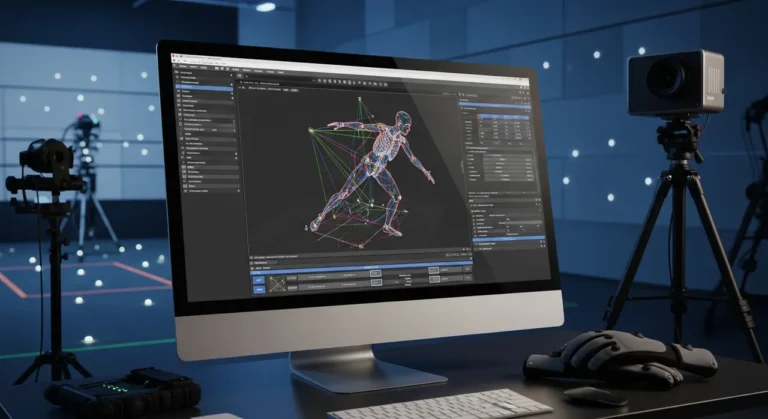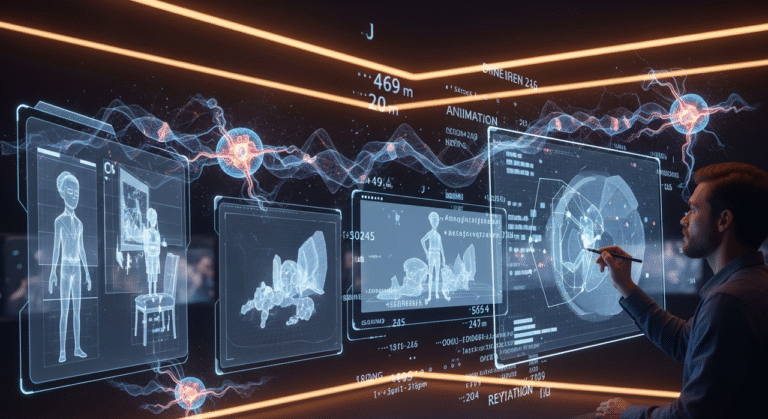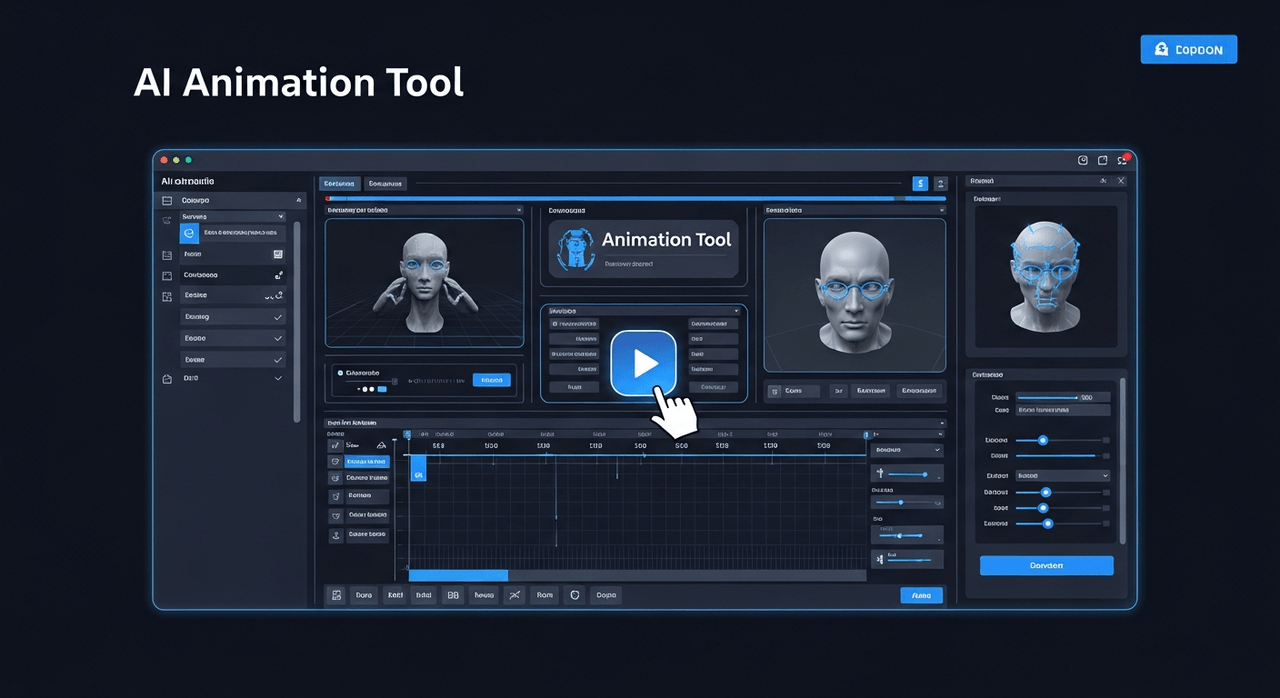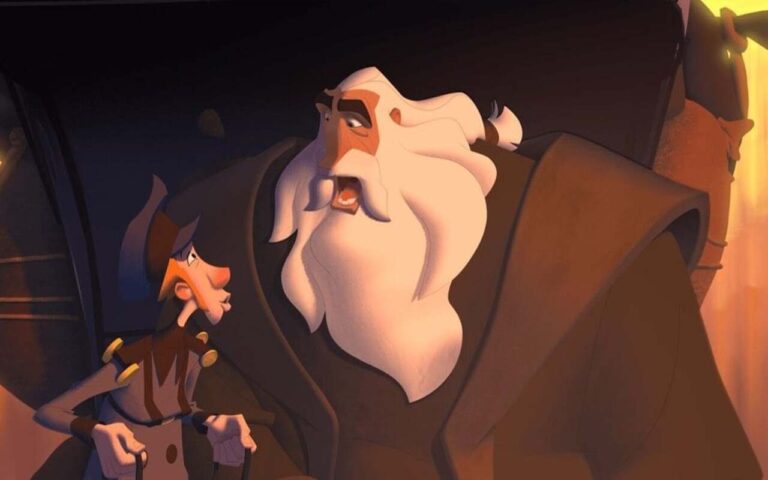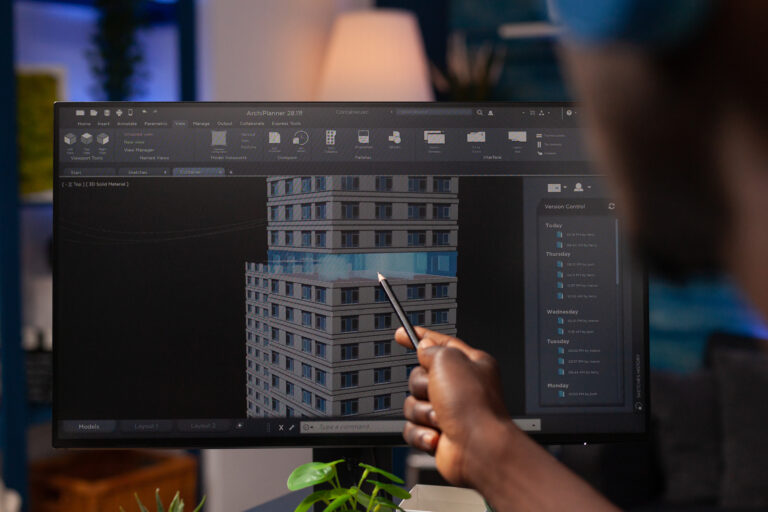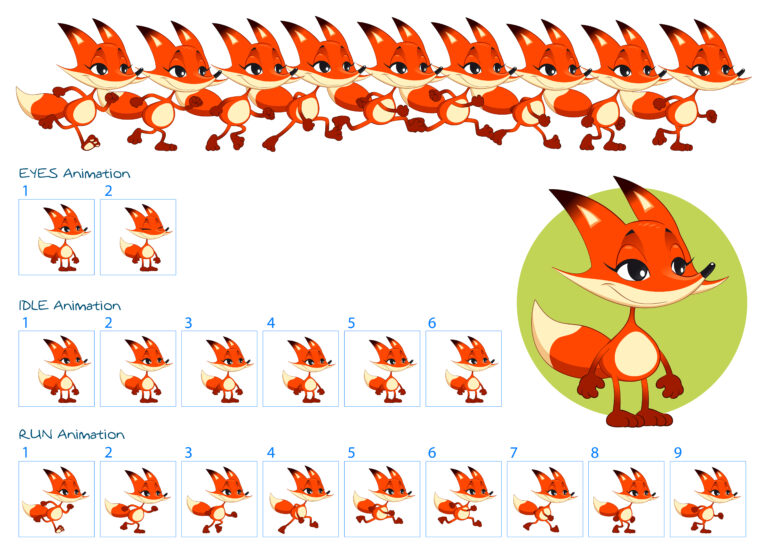Squash and stretch is a fundamental technique used by animation studios to exaggerate movement and impressions of characters or objects. Though pioneered in the 1930s by Disney studios, it still remains an essential principle today.
When applied thoughtfully, squash and stretch can show weight, force, flexibility and emotion throughout the movement of any subject. This article will explore the technical concepts behind effective squash and stretch.

Need Animation Services?
Visit our Animation Service page to see how we can help bring your ideas to life!
What is Squash And Stretch
By far the most important discovery was squash and stretch. Squash and stretch involve deforming an object or character along certain axes to exaggerate motion and impacts. Squash techniques reduce important dimensions, abruptly flattening objects against forces. Stretches elongate forms, exaggerating rebounds and elasticity. Together, these manipulate an object’s volume and proportions over time.
Though it was first introduced as one of the 12 Principles of animation as a 2D technique, the same rules and steps are applied to 3D animations as well.
When a fixed shape is moved about on the paper from one drawing to the next, the movement emphasizes a marked rigidity. In real life, this occurs only with the most rigid shapes, such as chairs, dishes and pans. Anything composed of living flesh, no matter how bony, will show considerable movement within its shape in progressing through and action.
A good example of this is the bent arm with swelling biceps straightened out so that only the long sinews are apparent. The figure crouched is obviously contracted into itself, in contrast to the figure in an extreme stretch or leap.
I highly recommend that you read Disney Animation: The Illusion of Life. A book by Frank Thomas and Ollie Johnston. It will highly impact your understanding of any topic related to animation.

Why Is Squash and Stretch Important in Animation?
Squash and stretch is not a design decision—it’s one of the invisible rules that lend life and credibility to animated objects. From determining the weight of objects to animating personality in character design, the technique becomes a crucial aspect of successful motion design.
How It Impacts Motion Realism
Real-world movement is elastic. Look at the manner in which a rubber ball distorts when it bounces off the ground—it compresses and then stretches upward when it springs back. Squash and stretch imitate these natural deformations to simulate physics, gravity, and momentum. Without using this principle, animation appears wooden and unreal.
Emotional Expression Through Deformation
Aside from realism, squash and stretch also serve as effective emotional delivery tools. The face can be squashed to frustration or stretched to joy. Those minimal exaggerations of movement make emotional beats more effective, and the animation more real and interesting.
Creating Appealing Characters
Appeal is perhaps the most critical ingredient of great character animation. Squash and stretch bring life to all movement, from the blink to the big leap. The character becomes more playful, more stylized, and more enjoyable to view—things that tantalize the eyes and heighten the story.
Historical Evolution of Squash and Stretch
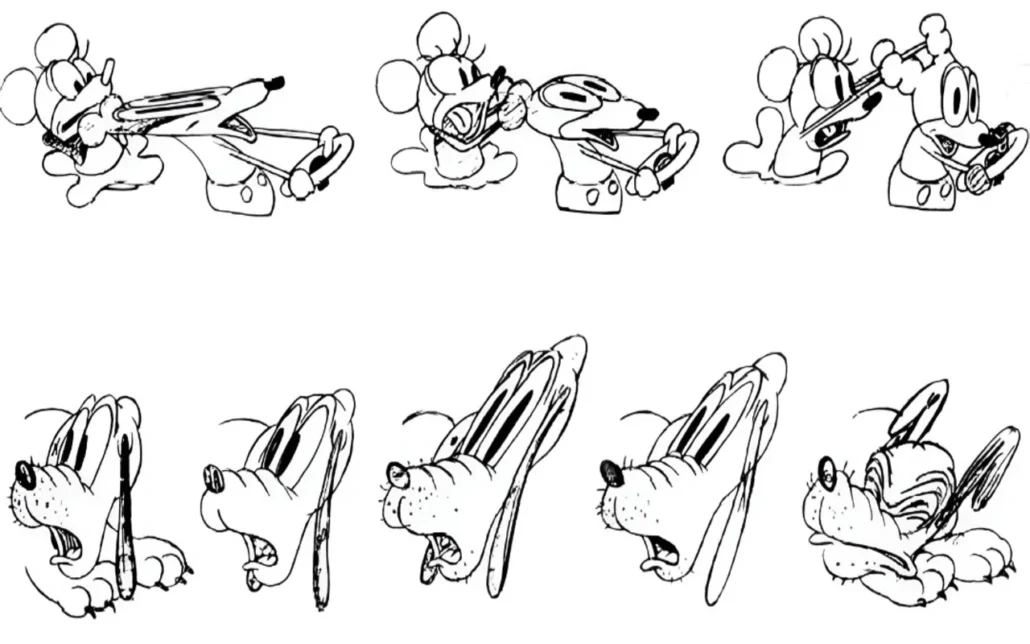
While squash and stretch might be second nature in animation these days, it was something that needed to be discovered, invented, and refined. Learning about its heritage can heighten your appreciation of how far animation has come.
Developed by Disney animators Frank Thomas and Ollie Johnston, who were born early in the 1930s, squash and stretch became an out-of-date method. In cartoons like Steamboat Willie and Snow White, the artists began experimenting with the stretchability of form in order to bring cartoon characters to life. With time, this phenomenon spread from the realm of cartoons to every type of animated storytelling—from realistic 3D and 2D animation to stop motion and video games.
Deep Dive Into Squash and Stretch
“Squash” means flattening or compressing along a certain axis, like a ball squashing vertically when bouncing. “Stretch” refers to elongating or enlarging a form, like a ball stretching vertically on the rebound. Used together, squash and stretch create the illusion of weight and flexibility. The same rule is applied when you add the z-axis to the equation.
The squashed position can depict the flattened out by great pressure or bunched up and pushed together. The stretched position always shows the same form in a very extended condition.
Squash compression occurs over just a few frames to communicate abrupt impacts. The “anticipation” build-up leading into the squash contributes to this effect. Stretches unfold more slowly to sell the elasticity and momentum. This timing contrast is key. Volume consistency must also be maintained. No matter how squashed or stretched, the total mass remains the same.
The best advice for keeping the distended drawings from looking bloated or bulbous and the stretched position from appearing stringy or withered was to consider that the shape or volume was like a half-filled flour sack. If dropped on the floor, it will squash out to its fullest shape, and if picked up by the corners, it will stretch out to its longest shape. Yet, it will never change volume.

Executing Squashes and Stretches
The technical execution of convincing squashes and stretches relies on a deep understanding of animation fundamentals.
Sharp timing is used over just a few frames for squashes to communicate impact. Volume is preserved by uniformly scaling along compressed axes. Mesh deformers and shape keys provide artistic control over the squashing effect. Proper edge topology flow must be maintained to avoid distortions during extreme flattening or compressions. Weight and force are emphasized through the extremity of the squash. Overlapped actions and secondary motion create follow-through.
Stretches unfold over more frames using slowed timing for anticipation. Volume is again preserved by uniform scaling along elongated axes. Bone scaling hierarchies and stretchy IK constraints are leveraged to achieve naturalistic stretching. It is crucial to order scale operations before joint rotations for natural motion. Rebounds and flexibility are exaggerated through extreme elongation. Overlapped actions like jiggling flesh enhance the effect.
Facial squashing and stretching require extensive shape key libraries for various mouth, eye, cheek poses and so on. Carefully painted blend weights localize deformations on the face. Corrective shapes maintain mesh quality at extremes. Character animation is driven by bones and control curves. Secondary jiggle dynamics on loose facial features add realism. Eyes, noses, lips, cheeks and other parts are squashed and stretched to enhance personality and acting.
The core guideline is to apply squash and stretch techniques in ways that serve the overall acting and storytelling of the character animation company. Convincing squashes and stretches make characters feel more dynamic, natural and appealing.

Applying the Technique Thoughtfully
Squash and stretch should augment performances, not overwhelm them. Subtlety is key for believability. Overdoing these techniques results in cartoony distortion. Follow key principles like anticipation, slow-in and slow-out, overlap, follow-through and secondary motion. Allow the personality and mood of the character to dictate the degree of deformation. Make sure squashes and stretches contribute to storytelling rather than distracting.
Mastering squash and stretch allows animators to bring natural bounce, flexibility and expression to characters. These techniques remain vital tools for achieving the exaggerated magic of animation. When applied convincingly, squash and stretch can make the difference between a lifeless puppet and a charismatic, dynamic character. Understanding the foundational principles allows animators to utilize squash and stretch to maximum effect.
Squash and Stretch in 2D vs 3D Animation
The growth of animation has also seen the usage of squash and stretch. Though the concept is unchanged, its application is different for hand-drawn 2D and computer-based 3D animation.
Key Differences and Similarities
Squash and stretch are drawn frame by frame manually in 2D animation. In 3D, it is digitally controlled by 3D rigging and mesh deformation. While these are distinct processes, the end result is squashing and stretching form with preserved volume and believability.
Adapting Principles Across Mediums
Subtlety is needed to translate 2D exaggeration into 3D realism. More subtle rig controls, scaling, and motion curves are used in 3D to simulate the illusion without dismembering the model. For artistic purposes, in 2D, more exaggeration of form can be done.
Tools for 2D and 3D Implementation
2D animation software like Toon Boom Harmony or Adobe Animate enable frame-by-frame control. In 3D, applications like Blender, Maya, and Cinema 4D use rigging methods that employ shape keys, deformers, and bespoke constraints to attain dynamic squash and stretch.
Common Mistakes to Avoid When Using Squash and Stretch
Whereas squash and stretch are very powerful in animation, overuse will have the opposite effect. Below are some common mistakes that rob the effect.
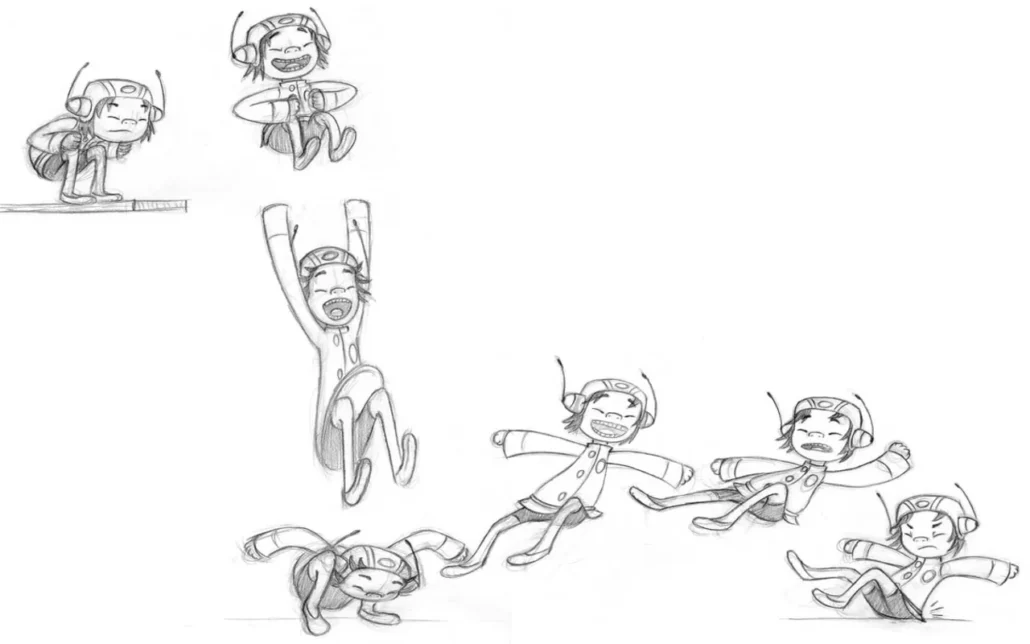
Ignoring Volume Consistency
One of the golden rules: volume must stay constant. A squashed sphere should look neither heavier nor lighter than a stretched one. Breaking this ruins the illusion of a hard body and makes your animation “off.”
Over-Exaggerating Without Purpose
Exaggeration works best when it’s working for the scene. Too much squash and stretch can make even grim situations look ridiculous. Be mindful of context—sometimes, subtle deformation is more effective than grand deformation.
Misaligned Timing and Deformation
Timing is everything. A lagging squash or an anticipatory onset for a stretch can destroy motion continuity.
Tools and Software That Help With Squash and Stretch
We are blessed today that animators can leverage many available tools and software to make it a breeze to apply squash and stretch. Some of the best in the business are listed below.
Famous Software
- Blender: Robust and free, Blender contains advanced rigging and shape key systems perfectly suited for dynamic deformation.
- Maya: Professional level for 3D animation with intense rigging and constraint systems for facilitating proper squash and stretch control.
- After Effects: Suitable for motion graphics and 2D-style animation with puppet tools, scaling, and easing keyframes.
Shape Keys, Mesh Deformers, and IK Constraints
Shape keys allow you to sculpt out specific stretched or squished forms. Mesh deformers provide you with smooth manipulation of large areas. IK (inverse kinematics) constraints help you stretch limbs naturally, especially character rigs.
Plugins and Scripts to Enhance Workflow
Third-party plugins like Rigify for Blender or Advanced Skeleton for Maya do the deformation rigging for you in most cases. Scripts can also maintain volume or scale automatically from motion curves.
Case Studies: Iconic Uses of Squash and Stretch
Studying great animation teaches you how to apply those skills confidently. Some of the most iconic examples follow.
Classic Disney Characters
Watch old Mickey or Goofy cartoons, and you’ll observe squash and stretch in use—especially on jumps, hits, and face positions. All-out exaggerated motion made the characters cute and spirited.
Modern Animated Films and Games
In films such as Pixar’s The Incredibles or Toy Story, squash and stretch are used sparingly to achieve realism without overdoing it. In others, such as Cuphead, the concept is utilized to the fullest to obtain the classic 1930s cartoon look.
What We Can Learn From These Examples
The takeaway? The ideal squash and stretch is adaptable in style, tone, and medium. Use just enough to sell weight, emotion, and personality—whether it’s in cartoons or realistic 3D animation.
How to Practice Squash and Stretch as a Beginner
You don’t have to be in a studio to learn squash and stretch. With some exercises and plenty of observation, you can pick up the basics in the comfort of your own home.
- Start With a Bouncing Ball: This is the old standby warm-up exercise. Bounce a ball down and squash as it travels downward, and stretch as it rises up. Get the timing and the volume going.
- Animate Simple Characters: Stick figures or flour sack animation are ideal for practice. These kinds of shapes are easy to deform and great for practice in expressing personality through deformation.
- Break Down Frames from Reference Animations: Choose one of your most popular cartoon moments, stop it frame by frame, and examine how squash and stretch have been used. Try redrawing these frames to train your hands and eyes.
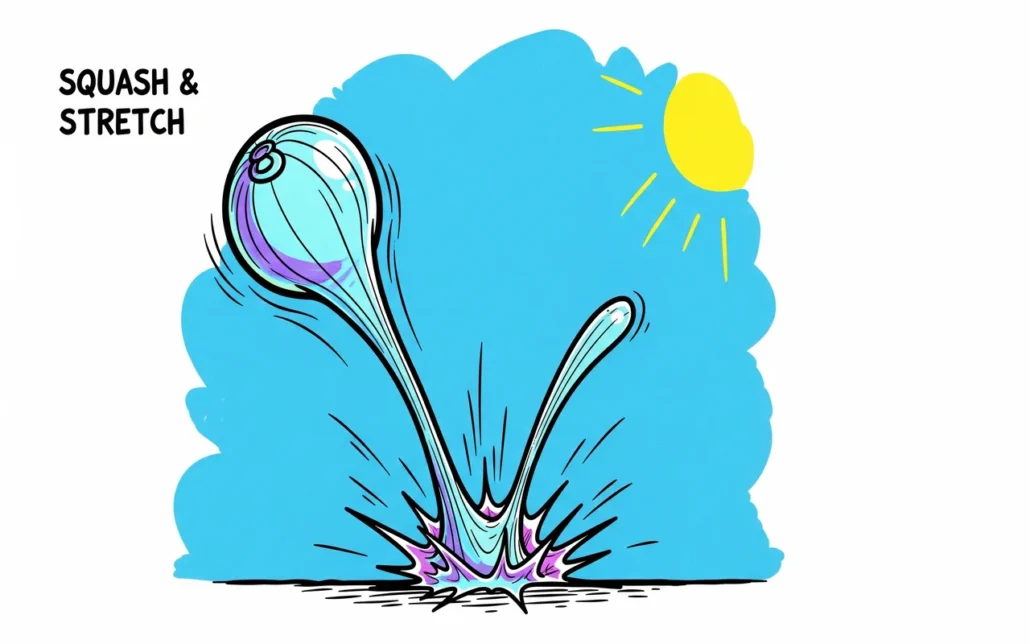
Beyond Characters: Squash and Stretch in Objects and Effects
Characters aren’t the only subject that gets animated with kinetic movement. Squash and stretch also animate objects, environments, and visual effects.
- Using the Technique on Props and Particles: Visualize a sword flying through the air after a collision or an apple bouncing on TV. Deformation on props will provide that slight extra bounce and realism.
- Adding Meat to Environmental Animations: Nature can also stretch and squash. Swinging trees, crashing waves, or puffy clouds—these, too, can subtly employ deformation to become more kinetic.
- Adding Weight to Non-Living Objects: To make a bag of flour heavy or a cube of jelly soft, provide squash and stretch gently. These minute details do quite a bit of help in making the animation more engaging.
Enhancing Storytelling with Squash and Stretch
Animation at its core is about storytelling, and squash and stretch are fantastic tools to yell out the story louder.
- Employing Motion to Express Personality: A brash character will stretch tall, and a shy one squashes down. These physical movements support personality and enable the audience to read emotions in an instant.
- Accentuating Comedy or Drama with Timing: Stretch and squash can be overdone to assist gags in comedy. Subtlety adds an extra richness to emotion in drama. Consider how a deep sigh can squish the shoulders of a character just slightly.
- When to Go Subtle vs Exaggerated: It’s also important to know when to remain restrained. Forceful deformation is not required every second. Use the forceful squash and stretch for passionate moments or times of physical need, and otherwise use lightness to preserve balance.
Conclusion
Though pioneered decades ago, squash and stretch remain one of animation’s most important techniques for bringing characters to life. Executed well, it imbues natural weight, flexibility and personality into every movement.
Squash and stretch require technical mastery of timing, volume preservation and deformation tools. Yet its true power comes from understanding the principles behind exaggerating motion realistically. Animators must apply squash and stretch with nuance and subtlety, supporting the acting and storytelling.
